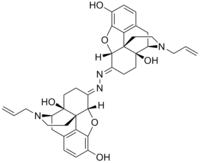Naloxonazine

| |
| Names | |
|---|---|
| Other names
NIH 10894; NSC 612113, Bis-[5-α-4,5-Epoxy-3,14-dihydroxy-17-(2-propenyl)-morphinan-6-ylidene] hydrazine dihydrochloride
| |
| Identifiers | |
CAS Number
|
|
3D model (JSmol)
|
|
| ChEMBL | |
| ChemSpider | |
IUPHAR/BPS
|
|
PubChem CID
|
|
CompTox Dashboard (EPA)
|
|
InChI
| |
| |
| Properties | |
Chemical formula
|
C38H42N4O6 |
| Molar mass | 650.776 g·mol−1 |
Except where otherwise noted, data are given for materials in their standard state (at 25 °C [77 °F], 100 kPa). | |
| Infobox references | |
Naloxonazine is a potent, irreversible μ-opioid receptor antagonist.[1] Naloxonazine forms spontaneously in acidic solutions of naloxazone, and may be responsible for much or all of the irreversible μ opioid receptor binding displayed by the latter.[2]
See also[]
- Oxymorphone-3-methoxynaltrexonazine, a similar opioid also having two complete and mirrored morphinan carbon skeletons
References[]
- ^ Naloxonazine dihydrochloride
- ^ Hahn, E. F.; Pasternak, G. W. (September 1982). "Naloxonazine, a potent, long-lasting inhibitor of opiate binding sites". Life Sciences. 31 (12–13): 1385–1388. doi:10.1016/0024-3205(82)90387-3. PMID 6292633.
Categories:
- Morphinans
- Mu-opioid receptor antagonists
- Phenols
- Allyl compounds
- Semisynthetic opioids
- Alkylating agents
- Irreversible antagonists
- Analgesic stubs